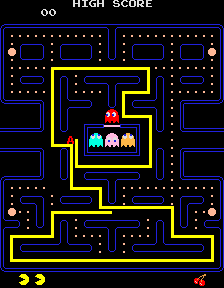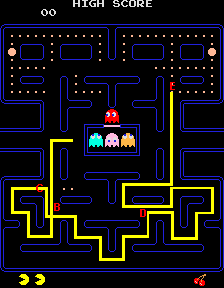 POV: DESIGNER. DIFFICULTY 3. LEVEL 4 – 1
POV: DESIGNER. DIFFICULTY 3. LEVEL 4 – 1
My recent deep dive into Pac-Man’s design and high-level gameplay got me thinking about randomness and deterministic design elements. I’m quite a fan of randomness in game design, though it has its pros and cons. Pros include variation and unpredictability that force player improvisation. Cons include a lowered skill ceiling and a lack of player control.
The original Pac-Man arcade version strikes a delicate balance between randomization and determinism with its Ghost AI design. In Pac-Man the Ghosts change back and forth between chase and scatter AI modes. In both modes, Ghost movement is determined by a number of factors including the other Ghosts’ positions and Pac-Man’s position. Given the same positions, the Ghosts will act the same way every time.
When Pac-Man eats a power-pellet, the Ghosts run from Pac-Man in a frightened state. At every turn, they make a random decision which way to go. During this time, Pac-Man usually has zero threats on the field, so the random Ghost movement mostly affects the player’s ability to maximize score as opposed to limiting their ability to make informed decisions at times when their life is on the line. It’s a touch of randomness that that proves the skill of the designer and the potency of randomness as a design element.
On the highest difficulty levels, Ghosts don’t turn blue and don’t become vulnerable even when Pac-Man eats a Power-Pellet! Here, the exact positions of Ghosts is the result of a complex web of deterministic rules. If you play precisely the same way every time, the Ghosts will move predictably through the maze. Of course, it takes considerable planning and skill to work out a whole pathing “patterns” for these levels, but some elite players have done it and can pull them off reliably.
 images from mameworld.info
images from mameworld.info

If the perfectly planned pathing pattern is mistimed by even a frame or two, if Pac-Man’s movements are not in exactly the right place at the right time, the Ghost AI will react differently, starting a chain reaction of unplanned and less predictable Ghost movement. When that happens, even the best players have to improvise.
Low- and high-level players both experience the pros of randomness playing the Pac-Man arcade game. The random Ghost frighten movement creates unpredictable challenges without threatening the player in a way that creates unfair deaths. Both knowledge and adaptation (improvisation) are required to succeed. But on the final level of difficulty, expert players engage Pac-Man in a new way, using their skill to maximize score and minimize the unknown. To play at this level of skill, players need impeccable timing and incredible precision. With a microscopic misstep, even the most pre-planned gameplay turns back into the Pac-Man experience that everyone is familiar with.



